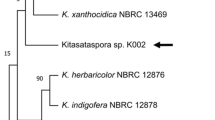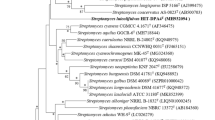Abstract
A novel actinobacterial strain, designated 10F1D-1T, was isolated from soil sample collected from Futian mangrove nature reserve, China using of the in situ cultivation technique. Preliminary analysis based on the 16S rRNA gene sequence revealed that strain 10F1D-1T was the member of genus Schumannella with sharing highest sequence similarity (99.7%) to Schumannella luteola DSM 23141T. Phylogenetic analyses based on 16S rRNA gene sequences and core proteome consistently exhibited that strain 10F1D-1T formed a monophyletic clade with Schumannella luteola DSM 23141T. Comparative genomic analyses clearly separated strain 10F1D-1T from the only species of the genus Schumannella based on average nucleotide identity (ANI), average amino acid identity (AAI) and digital DNA-DNA hybridization (dDDH) values below the thresholds for species delineation. The genome of strain 10F1D-1T contains the biosynthetic gene clusters for osmoprotectants to adapt to the salt environment of mangrove. Strain 10F1D-1T also contains the biosynthetic gene clusters for bioactive compounds as secondary metabolites. On the basis of the polyphasic analysis, strain 10F1D-1T is considered to represent a novel species of the genus Schumannella, for which the name Schumannella soli sp. nov. (type strain 10F1D-1T = CGMCC1.16699T = JCM 33146T) is proposed.


Similar content being viewed by others
Data availability
All data generated and analyzed in present study are included in this published article, supplementary files and GenBank/EMBL/DDBJ.
References
An SY, Xiao T, Yokota A (2008) Schumannella luteola gen. nov., sp. nov., a novel genus of the family Microbacteriaceae. J Gen Appl Microbiol 54:253–258
Avram O, Rapoport D, Portugez S, Pupko T (2019) M1CR0B1AL1Z3R-a user-friendly web server for the analysis of large-scale microbial genomics data. Nucleic Acids Res 47:W88–W92
Berdy B, Spoering AL, Ling LL, Epstein SS (2017) In situ cultivation of previously uncultivable microorganisms using the ichip. Nat Protoc 12:2232–2242
Blin K, Shaw S, Kloosterman AM, Charlop-Powers Z, van Wezel GP, Medema MH, Weber T (2021) antiSMASH 6.0: improving cluster detection and comparison capabilities. Nucleic Acids Res 49:W29–W35
Bolger AM, Lohse M, Usadel B (2014) Trimmomatic: a flexible trimmer for Illumina sequence data. Bioinformatics 30:2114–2120
Bremer E, Krämer R (2019) Responses of microorganisms to osmotic stress. Annu Rev Microbiol 73:313–334
Chun J, Rainey FA (2014) Integrating genomics into the taxonomy and systematics of the Bacteria and Archaea. Int J Syst Evol Microbiol 64:316–324
Chun J, Oren A, Ventosa A, Christensen H, Arahal DR, da Costa MS, Rooney AP, Yi H, Xu XW, De Meyer S, Trujillo ME (2018) Proposed minimal standards for the use of genome data for the taxonomy of prokaryotes. Int J Syst Evol Microbiol 68:461–466
Collins MD, Pirouz T, Goodfellow M, Minnikin DE (1977) Distribution of menaquinones in actinomycetes and corynebacteria. J Gen Microbiol 100:221–230
DeLong EF (1992) Archaea in coastal marine environments. Proc Natl Acad Sci USA 89:5685–5689
Epstein SS (2013) The phenomenon of microbial uncultivability. Curr Opin Microbiol 16:636–642
Felsenstein J (1981) Evolutionary trees from DNA sequences: a maximum likelihood approach. J Mol Evol 17:368–376
Felsenstein J (1985) Confidence limits on phylogenies: an approach using the bootstrap. Evolution 39:783–791
Finn RD, Clements J, Eddy SR (2011) HMMER web server: interactive sequence similarity searching. Nucleic Acids Res 39:W29–W37
Fitch WM (1971) Toward defining the course of evolution: minimum change for a specific tree topology. Syst Biol 20:406–416
Galperin MY, Makarova KS, Wolf YI, Koonin EV (2015) Expanded microbial genome coverage and improved protein family annotation in the COG database. Nucleic Acids Res 43:D261–D269
Gavrish E, Bollmann A, Epstein S, Lewis K (2008) A trap for in situ cultivation of filamentous actinobacteria. J Microbiol Methods 72:257–262
Gonzalez C, Gutierrez C, Ramirez C (1978) Halobacterium vallismortis sp. nov., an amylolytic and carbohydrate-metabo-lizing, extremely halophilic bacterium. Can J Microbiol 24:710–715
Goris J, Konstantinidis KT, Klappenbach JA, Coenye T, Vandamme P, Tiedje JM (2007) DNA-DNA hybridization values and their relationship to whole-genome sequence similarities. Int J Syst Evol Microbiol 57:81–91
Guo L, Tuo L, Habden X, Zhang Y, Liu J, Jiang Z, Liu S, Dilbar T, Sun C (2015) Allosalinactinospora lopnorensis gen. nov., sp. nov., a new member of the family Nocardiopsaceae isolated from soil. Int J Syst Evol Microbiol 65:206–213
Jones DT, Taylor WR, Thornton JM (1992) The rapid generation of mutation data matrices from protein sequences. Comput Appl Biosci 8:275–282
Kaeberlein T, Lewis K, Epstein SS (2002) Isolating “uncultivable” microorganisms in pure culture in a simulated natural environment. Science 296:1127–1129
Kelly KL (1964) Inter-society color council-national bureau of standards color name charts illustrated with centroid Colors. US Government Printing Office, Washington, DC
Kovacs N (1956) Identification of Pseudomonas pyocyanea by the oxidase reaction. Nature 178:703
Kumar S, Stecher G, Tamura K (2016) MEGA7: Molecular evolutionary genetics analysis version 7.0 for bigger datasets. Mol Biol Evol 33:1870–1874
Lewis K, Epstein S, D’Onofrio A, Ling LL (2010) Uncultured microorganisms as a source of secondary metabolites. J Antibiot 63:468–476
Li WJ, Xu P, Schumann P, Zhang YQ, Pukall R, Xu LH, Stackebrandt E, Jiang CL (2007) Georgenia ruanii sp. nov., a novel actinobacterium isolated from forest soil in Yunnan (China) and emended description of the genus Georgenia. Int J Syst Evol Microbiol 57:1424–1428
Li FN, Lu Q, Liao SL, Jin T, Li W, Sun CH (2019a) Labedella phragmitis sp. nov. and Labedella populi sp. nov., two endophytic actinobacteria isolated from plants in the Taklamakan Desert and emended description of the genus Labedella. Syst Appl Microbiol 42:126004
Li F, Liu S, Lu Q, Zheng H, Osterman IA, Lukyanov DA, Sergiev PV, Dontsova OA, Liu S, Ye J, Huang D, Sun C (2019b) Studies on antibacterial activity and diversity of cultivable actinobacteria isolated from mangrove soil in Futian and Maoweihai of China. Evid Based Complement Alternat Med 2019:3476567
Lim HJ, Lee EH, Yoon Y, Chua B, Son A (2016) Portable lysis apparatus for rapid single-step DNA extraction of Bacillus subtilis. J Appl Microbiol 120:379–387
Liu SW, Ye JJ, Lu QP, Cheema MT, Abbas M, Huang DL, Sajid I, Sun CH (2020) Motilibacter deserti sp. nov. and Motilibacter aurantiacus sp. nov., two novel actinobacteria isolated from soil of Cholistan Desert and emended description of the genus Motilibacter. Syst Appl Microbiol 43:126150
Lombard V, Golaconda Ramulu H, Drula E, Coutinho PM, Henrissat B (2014) The carbohydrate-active enzymes database (CAZy) in 2013. Nucleic Acids Res 42:D490–D495
Magee CM, Rodeheaver G, Edgerton MT, Edlich RF (1975) A more reliable gram staining technic for diagnosis of surgical infections. Am J Surg 130:341–346
Makihara F, Tsuzuki M, Sato K, Masuda S, Nagashima KV, Abo M, Okubo A (2005) Role of trehalose synthesis pathways in salt tolerance mechanism of Rhodobacter sphaeroides f. sp. denitrificans IL106. Arch Microbiol 184:56–65
Meier-Koltho JP, Auch AF, Klenk HP, Göker M (2013) Genome sequence-based species delimitation with confidence intervals and improved distance functions. BMC Bioinform 14:60
Mikheenko A, Valin G, Prjibelski A, Saveliev V, Gurevich A (2016) Icarus: visualize for de novo assembly evaluation. Bioinformatics 32:3321–3323
Minnikin DE, O’Donnell AG, Goodfellow M, Alderson G, Athalye M, Schaal A, Parlett JH (1984) An integrated procedure for the extraction of bacterial isoprenoid quinones and polar lipids. J Microbiol Methods 2:233–241
Saitou N, Nei M (1987) The neighbor-joining method: a new method for reconstructing phylogenetic trees. Mol Biol Evol 4:406–425
Sasser M (1990) Identification of bacteria by gas chromatography of cellular fatty acids, MIDI Technical Note 101. MIDI inc., Newark
Sherpa RT, Reese CJ, Montazeri-Aliabadi H (2015) Application of iChip to grow “uncultivable” microorganisms and its impact on antibiotic discovery. J Pharm Pharm Sci 18:303–315
Stackebrandt E, Rainey FA, Ward-Rainey NL (1997) Proposal for a new hierarchic classification system, Actinobacteria classis nov. Int J Syst Bacteriol 47:479–491
Yoon SH, Ha SM, Kwon S, Lim J, Kim Y, Seo H, Chun J (2017) Introducing EzBioCloud: a taxonomically united database of 16S rRNA gene sequences and whole-genome assemblies. Int J Syst Evol Microbiol 67:1613–1617
Zhi XY, Li WJ, Stackebrandt E (2009) An update of the structure and 16S rRNA gene sequence-based definition of higher ranks of the class Actinobacteria, with the proposal of two new suborders and four new families and emended descriptions of the existing higher taxa. Int J Syst Evol Microbiol 59:589–608
Funding
This research was partly supported by the Drug Innovation Major Project of China (Grant No. 2018ZX09711001-007-001), CAMS Innovation Fund for Medical Sciences (Grant No. CAMS 2017-I2M-B&R-08) and PUMC Youth Fund (Grant No. 2017350022).
Author information
Authors and Affiliations
Contributions
FL designed the experiments and performed the identification. CS, FL, QL and SL carried out the sampling. SL, LT and QY supervised the phylogenetic analysis. QL and SL supervised the analyses of menaquinone and fatty acid. FL, CS and AS analyzed the results, wrote and approved the manuscript. All authors have read and agreed to the published version of the manuscript.
Corresponding authors
Ethics declarations
Conflict of interest
The authors declare that they have no conflict of interest.
Additional information
Publisher's Note
Springer Nature remains neutral with regard to jurisdictional claims in published maps and institutional affiliations.
Supplementary Information
Below is the link to the electronic supplementary material.
Rights and permissions
About this article
Cite this article
Li, F., Lu, Q., Liao, S. et al. Schumannella soli sp. nov., a novel actinomycete isolated from mangrove soil by in situ cultivation. Antonie van Leeuwenhoek 114, 1657–1667 (2021). https://doi.org/10.1007/s10482-021-01631-6
Received:
Accepted:
Published:
Issue Date:
DOI: https://doi.org/10.1007/s10482-021-01631-6




